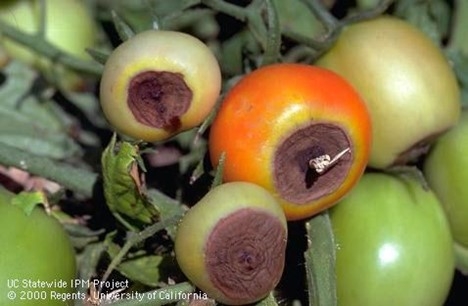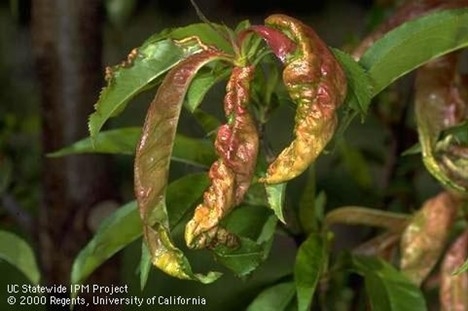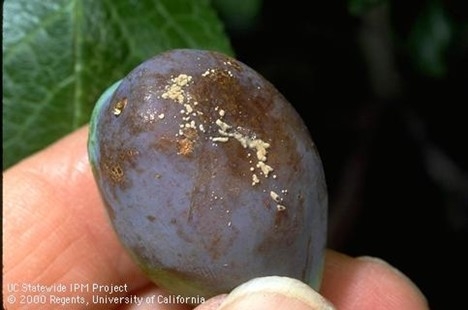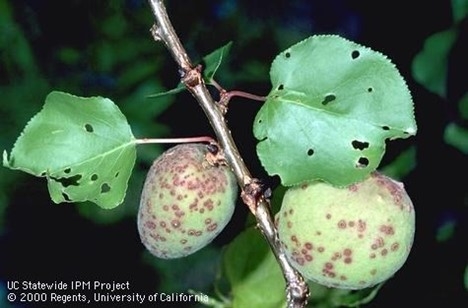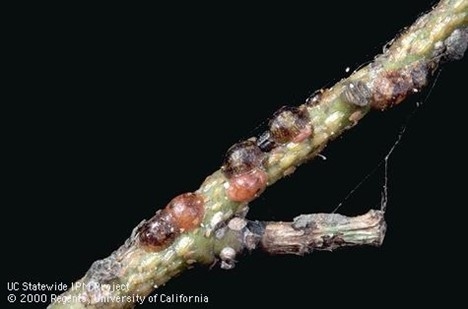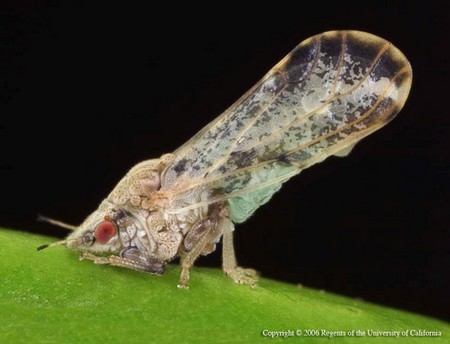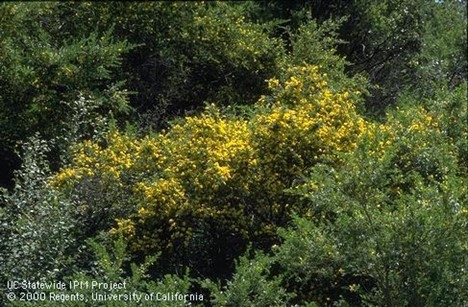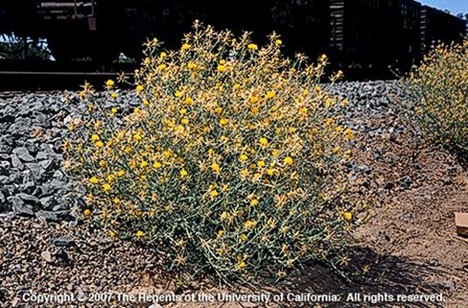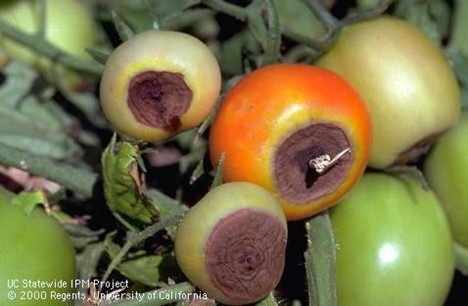Posts Tagged: Plant diseases
Lawn-pocalypse! Surviving Drought
Ah, summer! The season of sunburns, pool parties, and… lawn droughts. If your once lush, green carpet now looks like a crunchy brown doormat, you're not alone. Let's dive into why your yard is staging a dramatic death scene and what you can do to...

Bermuda grass and weeds overtaking drought stressed turf grass.
Blossom End Rot
This post is a rerun from 2023.
Have you noticed tomatoes that have round, water-soaked spots on the bottom? Blossom end rot (BER) is a frustrating problem that can be quite common in vegetable gardens, as it can affect tomatoes, peppers, and squash. You might notice it after a few very hot days. It usually starts on green fruit as a small, discolored spot on the end opposite the stem that might look water soaked. The spot enlarges and tissues dry out, becoming sunken, collapsed, and leathery.
Some tomato varieties, especially paste tomatoes, are affected more than others, but all varieties except cherry tomatoes seem to be susceptible if conditions are conducive. It is more likely to occur earlier in the season when plants are rapidly growing, but it can also show up later in the season when we have hot, dry weather.
Blossom end rot results from a low level of calcium in the fruit and a lack of water balance in the plant. Most of our soils have plenty of available calcium so there is no need to add more. Fluctuations in irrigation and/or heavy application of nitrogen are often the culprits in this condition. To reduce blossom end rot, monitor soil moisture to make sure the root zone neither dries out nor remains saturated. Follow recommended rates for vegetable fertilizers, using organic fertilizers.
Improvement in irrigation practices usually results in the problem going away. Rather than watering on a schedule, you should check the soil to determine its moisture level. Either by digging down into the soil without disturbing the roots or using a moisture meter, check to make sure the entire root zone is moist but not soggy. Use mulch around the plants to help maintain soil moisture, but make sure the mulch isn't right against the base of the plants.
Blossom end rot is not caused by a pathogen, so there are no pesticide solutions.
To reduce blossom-end rot:
• Use cover crops in the off season to increase water-holding organic matter in the soil.
• Irrigate before periods of hot weather.
• Don't disturb the root area.
• Don't over fertilize. Too much nitrogen during the early fruiting period can tie up calcium and make BER worse. Manure, especially poultry manure, can make it worse.
Vegetables affected by blossom end rot are still edible if they haven't begun to get moldy. Just cut away the discolored area.
More information about blossom end rot:
http://ipm.ucanr.edu/PMG/GARDEN/VEGES/ENVIRON/blossomendrot.html
Information about growing tomatoes in the home garden: https://anrcatalog.ucanr.edu/pdf/8159.pdf
Help Desk of the UC Master Gardeners of Contra Costa County (SEH)
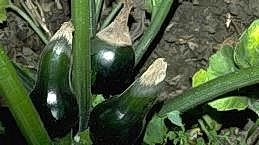
blossom end rot2
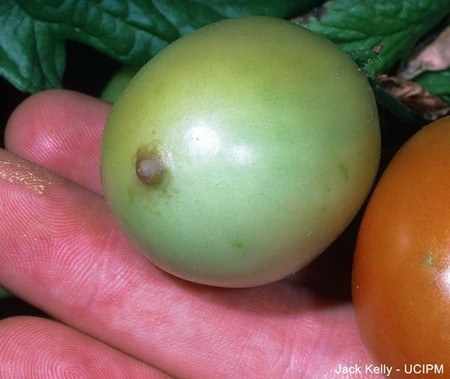
blossom end rot3-450
Is it Time to Use Dormant Sprays on Your Backyard Fruit Trees?
This year was particularly bad for peach leaf curl and other fungal infections in fruit trees because of the wonderful rain we had last winter and spring. It looks like we might have another wet winter, so we are rerunning this post to remind you to think about a spray program for your trees.
Now that the leaves have fallen, or mostly fallen, from your backyard fruit trees, are you wondering whether you should apply dormant sprays?
“Dormant sprays” or “delayed dormant sprays” are terms used for the application of pesticides when the tree is dormant or just coming into bud swell. The pesticide could be a fungicide used to help manage fungal disease or a horticultural oil or oil in combination with insecticides to kill insects.
Don't assume that you need dormant spray. Before reaching for the spray, first determine whether your trees have previously had a disease or serious insect pest problem that can be managed with dormant sprays. Have you already tried all non-chemical recommendations for lessening the problem? Finally, evaluate the amount of damage from the disease or insect pest you experienced in the prior growing season to decide whether a pesticide is really needed.
Fruit tree diseases that can be managed by applying a fungicide dormant spray include peach leaf curl, brown rot, and shot hole disease.
Peach Leaf Curl
Peach leaf curl affects only peach and nectarine trees. It shows up in spring after the tree has leafed out. Leaves are thickened, curled, and colored red or yellow instead of normal green.
If your tree has had significant peach leaf curl in prior years, dormant spraying with a fixed copper spray just after all the leaves have fallen from the tree (usually December to January in our County) may prevent or reduce the severity of the disease. For information on managing peach leaf curl, see https://ipm.ucanr.edu/PMG/PESTNOTES/pn7426.html/
Brown Rot
Brown rot (Monilinia) is a fungal disease that can affect peaches, plum, cherries, apricots, and nectarines. In the spring blossoms on infected trees shrivel and die, often clinging to the twigs. Leaves at the base of infected twigs may also turn brown and die. Fungal spores attach themselves to developing fruit and show up as brown or tan spots on the surface of the fruit.
If your trees had significant fruit loss from brown rot in the prior growing season, a dormant spray of a copper-based fungicide may help. Apply it at the pink bud stage while flower buds are still tightly curled and pink in color. For more information on brown rot, see http://ipm.ucanr.edu/PMG/GARDEN/FRUIT/DISEASE/aprbrownrot.html.
Shot Hole
Shot hole (Coryneum blight) can affect plums, nectarines, peaches, cherries, and especially apricots. It shows up as small reddish holes on leaf surfaces. Often the holes turn brown and drop out. Fruits may also be infected. Where disease has been severe and cultural steps haven't helped, a fungicide spray following complete leaf drop may be needed. See http://ipm.ucanr.edu/PMG/GARDEN/FRUIT/DISEASE/shothole.html.
Brown Soft Scale
Insects that can be managed with dormant sprays of horticultural oils or oils mixed with insecticides include scale, aphids, and spider mites. Don't spray unless you have confirmed that the insects are present in damaging numbers and cannot be controlled by other means. Keep in mind that spraying may also kill beneficial insects which are the first line of defense against insect pests.
More information on controlling these insect pests can be found at these UC websites: https://ipm.ucanr.edu/QT/scalescard.html
https://ipm.ucanr.edu/QT/aphidscard.html
https://ipm.ucanr.edu/QT/spidermitescard.html
Caution: Before spraying, read and carefully follow the label instructions on the pesticides you use, including wearing recommended protective gear.
Help Desk of UC Master Gardener Program of Contra Costa County (TKL)
Be Careful! Moving Pests Around Can Be Too Easy
A poet once said, “A weed is but an unloved flower.” Sometimes though, a weed, an insect, or a four-legged critter can become a dangerous pest. In a state like California where so much of our economy is agriculturally based, these pests can wreak havoc. In our home gardens they threaten our landscape and ornamental plants and make the creation of natural areas a significant challenge when they displace native plants and wildlife.
Exotic and Invasive
California's native ecosystems were uniquely adapted to our Mediterranean climate, with its dry summers and wet winters. However, as the population changed and grew with immigration alongside increased international travel and commerce, new species of plants, many bringing insects and pathogens with them, were imported from Asia and Europe (often inadvertently) and introduced into the landscape. These exotic plants sometimes failed and sometimes flourished. Sometimes we move them unwittingly from state to state as we travel. The result is that some exotics have become invasive, spreading through the native ecosystem.
You might recognize some of these pests. The pathogen that causes sudden oak death was accidentally introduced on nursery stock and is estimated to have killed more than 1 million oak and tanoak trees over the last decade. In addition to disease, invasive plants can change the composition of soil as scotch broom does by adding nitrogen to the soil, or outcompete shallow rooted native species during dry summer months as the star thistle does with its deep root system.
Of special concern currently is the Asian Citrus Psyllid (Diaphorina citri), a tiny insect that attacks all varieties of citrus, and is a vector for the bacterium that causes Huanglongbing (HLB) disease. An infestation can spread quickly and there is no cure for HLB. Although the psyllid is rarely seen in Northern California, it has become a serious problem in Southern California where it arrived from Mexico in 2008 and is slowly spreading north. The USDA notes that HLB “has devastated millions of acres of citrus production around the world, including in the United States.” http://ipm.ucanr.edu/PMG/PESTNOTES/pn74155.html
Steps to Take to Stop the Spread
We can all have an impact on the spread of invasive species into our ecosystem.
1. Become familiar with invasive pests, how to identify them, and where to find information. The UC IPM website is a good source of information about managing exotic and invasive pests. https://ipm.ucanr.edu/Invasive-and-Exotic-Pests/
2. When you see suspicious organisms, get help identifying them. Contact your local UC Master Gardener Program Help Desk or Agricultural Commission to report invasive species and to get help with managing them. https://www.cdfa.ca.gov/plant/
3. Inspect new plants carefully before planting them. When possible, plant native species — they are better adapted to our climate, support butterflies and other pollinators, and are less likely to have pest problems! https://plantright.org/
4. Don't bring plants into California from outside the state, and don't purchase invasive plant species. This includes planting gifts from friends across the country into your garden, and ordering online from nurseries that are outside of California. https://www.cal-ipc.org/
5. Buy your firewood where you burn it. Many pest insects and pathogens move with firewood. Don't move it far from its source. http://www.firewood.ca.gov/
To learn more about the invasive species prevalent in California, their impact and how to address them, the UC IPM website is a wealth of important information. We can all make a difference in protecting our beautiful state.
Help Desk of the UC Master Gardeners of Contra Costa County (RDH)
Blossom End Rot
Have you noticed tomatoes that have round, water-soaked spots on the bottom? Blossom end rot (BER) is a frustrating problem that can be quite common in vegetable gardens, as it can affect tomatoes, peppers, and squash. You might notice it after a few very hot days. It usually starts on green fruit as a small, discolored spot on the end opposite the stem that might look water soaked. The spot enlarges and tissues dry out, becoming sunken, collapsed, and leathery.
Some tomato varieties, especially paste tomatoes, are affected more than others, but all varieties except cherry tomatoes seem to be susceptible if conditions are conducive. It is more likely to occur earlier in the season when plants are rapidly growing, but it can also show up later in the season when we have hot, dry weather.
Blossom end rot results from a low level of calcium in the fruit and a lack of water balance in the plant. Most of our soils have plenty of available calcium so there is no need to add more. Fluctuations in irrigation and/or heavy application of nitrogen are often the culprits in this condition. To reduce blossom end rot, monitor soil moisture to make sure the root zone neither dries out nor remains saturated. Follow recommended rates for vegetable fertilizers, using organic fertilizers.
Improvement in irrigation practices usually results in the problem going away. Rather than watering on a schedule, you should check the soil to determine its moisture level. Either by digging down into the soil without disturbing the roots or using a moisture meter, check to make sure the entire root zone is moist but not soggy. Use mulch around the plants to help maintain soil moisture, but make sure the mulch isn't right against the base of the plants.
Blossom end rot is not caused by a pathogen, so there are no pesticide solutions.
To reduce blossom-end rot:
• Use cover crops in the off season to increase water-holding organic matter in the soil.
• Irrigate before periods of hot weather.
• Don't disturb the root area.
• Don't over fertilize. Too much nitrogen during the early fruiting period can tie up calcium and make BER worse. Manure, especially poultry manure, can make it worse.
Vegetables affected by blossom end rot are still edible if they haven't begun to get moldy. Just cut away the discolored area.
More information about blossom end rot:
http://ipm.ucanr.edu/PMG/GARDEN/VEGES/ENVIRON/blossomendrot.html
Information about growing tomatoes in the home garden: https://anrcatalog.ucanr.edu/pdf/8159.pdf
Help Desk of the UC Master Gardeners of Contra Costa County (SEH)

blossom end rot2

blossom end rot3-450

